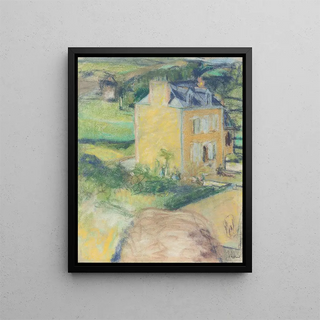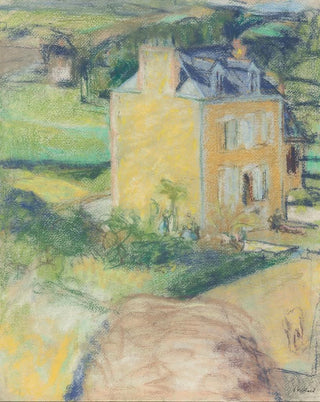Art print | Villa in Saint-Jacut - Édouard Vuillard


View from behind

Frame (optional)
Villa at Saint-Jacut by Édouard Vuillard – Captivating introduction
Édouard Vuillard's "Villa at Saint-Jacut" is much more than a simple depiction of a place; it is an invitation to immerse oneself in the intimacy of a moment frozen in time. This artwork, imbued with the artist's sensitivity, evokes a universe where light and shadow dance delicately across walls and furniture. Vuillard, a prominent figure of the Nabi movement, manages to capture the very essence of domestic life, transforming an ordinary moment into a scene filled with poetry. As you contemplate this piece, the viewer is transported to a space where nature and architecture meet, creating an atmosphere that is both warm and melancholic.
Style and uniqueness of the work
Vuillard's style is distinguished by his ability to blend reality and imagination. In "Villa at Saint-Jacut," soft colors and delicate patterns intertwine to form a harmonious composition. The artist uses brushstrokes that seem almost to vibrate, breathing palpable life into each depicted element. The characters, often present in the background, are enveloped in a halo of light that makes them both familiar and mysterious. This unique approach allows for an intimate connection with the subjects, as if one were a privileged guest in their space. Vuillard's play with textures and patterns evokes an atmosphere of comfort and serenity, making this artwork a true testament to the beauty of everyday life.
The artist and his influence
Édouard Vuillard, born in 1868, is an artist whose work has profoundly impacted the French art scene. A member of the Nabi group, he distanced himself from academic conventions to explore new forms of expression. His work, influenced by Impressionists and Symbolists, is characterized by meticulous attention to detail and a constant search for chromatic harmony. Vuillard was also a pioneer in the use of decorative painting, integrating his art into living spaces, which allowed him to explore the relationship between art and environment. His influence endures today, inspiring many contemporary artists to seek to

Matte finish

View from behind

Frame (optional)
Villa at Saint-Jacut by Édouard Vuillard – Captivating introduction
Édouard Vuillard's "Villa at Saint-Jacut" is much more than a simple depiction of a place; it is an invitation to immerse oneself in the intimacy of a moment frozen in time. This artwork, imbued with the artist's sensitivity, evokes a universe where light and shadow dance delicately across walls and furniture. Vuillard, a prominent figure of the Nabi movement, manages to capture the very essence of domestic life, transforming an ordinary moment into a scene filled with poetry. As you contemplate this piece, the viewer is transported to a space where nature and architecture meet, creating an atmosphere that is both warm and melancholic.
Style and uniqueness of the work
Vuillard's style is distinguished by his ability to blend reality and imagination. In "Villa at Saint-Jacut," soft colors and delicate patterns intertwine to form a harmonious composition. The artist uses brushstrokes that seem almost to vibrate, breathing palpable life into each depicted element. The characters, often present in the background, are enveloped in a halo of light that makes them both familiar and mysterious. This unique approach allows for an intimate connection with the subjects, as if one were a privileged guest in their space. Vuillard's play with textures and patterns evokes an atmosphere of comfort and serenity, making this artwork a true testament to the beauty of everyday life.
The artist and his influence
Édouard Vuillard, born in 1868, is an artist whose work has profoundly impacted the French art scene. A member of the Nabi group, he distanced himself from academic conventions to explore new forms of expression. His work, influenced by Impressionists and Symbolists, is characterized by meticulous attention to detail and a constant search for chromatic harmony. Vuillard was also a pioneer in the use of decorative painting, integrating his art into living spaces, which allowed him to explore the relationship between art and environment. His influence endures today, inspiring many contemporary artists to seek to






